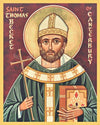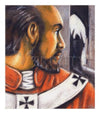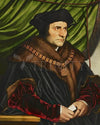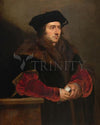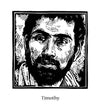Collection: St. Thomas More

-
Sale
Wood Plaque Premium
Regular price From $99.95 USDRegular priceUnit price per$111.06 USDSale price From $99.95 USDSale -
Sale
Wood Plaque
Regular price From $34.95 USDRegular priceUnit price per$38.83 USDSale price From $34.95 USDSale -
Sale
Wall Frame Espresso
Regular price From $109.95 USDRegular priceUnit price per$122.17 USDSale price From $109.95 USDSale -
Sale
Wall Frame Gold
Regular price From $109.95 USDRegular priceUnit price per$122.17 USDSale price From $109.95 USDSale -
Sale
Wall Frame Black
Regular price From $109.95 USDRegular priceUnit price per$122.17 USDSale price From $109.95 USDSale -
Sale
Canvas Print
Regular price From $84.95 USDRegular priceUnit price per$94.39 USDSale price From $84.95 USDSale -
Sale
Metal Print
Regular price From $94.95 USDRegular priceUnit price per$105.50 USDSale price From $94.95 USDSale -
Sale
Acrylic Print
Regular price From $94.95 USDRegular priceUnit price per$105.50 USDSale price From $94.95 USDSale -
Sale
Giclée Print
Regular price From $19.95 USDRegular priceUnit price per$22.17 USDSale price From $19.95 USDSale -
Custom Text Note Card
Regular price From $300.00 USDRegular priceUnit price per$333.33 USDSale price From $300.00 USDSale
ARTIST: Julie Lonneman
ARTWORK NARRATIVE:
English lawyer, author, and statesman Thomas More was a leading humanist scholar and occupied many public offices, including that of Lord Chancellor from 1529 to 1532. Despite his demanding occupation, Thomas was a devoted husband and father and fostered religious traditions within his family. He always spent Fridays in prayer. Thomas resigned his chancellorship to protest King Henry VIII's claim to be supreme head of the Church of England. His dissent ended his political career and led to his execution for treason in the Tower of London.
"Nothing can come but what God allows. And I am very sure that whatever that be, however bad it might seem, it shall indeed be the best."
—Saint Thomas More, in a letter from prison to his daughter Meg.
England, 1477-1535.
His feast day is June 22.
- Art Collection:
-
Saints & Angels
- Patronage:
-
Widowers,
-
Step-parents,
-
Politicians,
-
Lawyers,
-
Diocese of Arlington VA,
-
Difficult Marriages,
-
Court Clerks,
-
Adopted Children
- Lonneman collection:
-
Models of Faith
By his early 20's he was lecturing on St. Augustine's City of God to some of the foremost minds of his day as well as rising rapidly through the ranks of his profession to become a prominent figure in English society.
More was a man of enormous personal integrity. On one occasion, More opposed King Henry VII over his excessive taxation and won. A friend of the King's told More that his boldness would have cost him his head but for the fact that he had not attacked the king in person. Still, Henry was so enraged with More that he imprisoned his father till he had made him pay a hundred pounds fine.
More wrestled for some time as a young man with the question of his vocation to the priesthood. However, when it became clear to him that this was not his calling, he set earnestly to work on the vocation to which God was calling him: secular life and marriage. His first marriage was to Jane Colte, in 1505. Roper, his son-in-law, writes of his choice: "albeit his mind most served him to the second daughter, for that he thought her the fairest and best favored, yet when he considered that it would be great grief and some shame also to the eldest to see her younger sister preferred before her in marriage, he then, of a certain pity, framed his fancy towards" the eldest of the three sisters. The union proved joyous; of it were born three daughters, Margaret, Elizabeth, and Cecilia, and a son, John.
Of the More household, friends and relatives provide us a delightful portrait. Thomas was known all his life as a merry man. His friend, the great scholar Erasmus, writes:
His countenance is in harmony with his character, being always expressive of an amiable joyousness, and even an incipient laughter and, to speak candidly, it is better framed for gladness than for gravity or dignity, though without any approach to folly or buffoonery.. He is full of jokes and banter. No one is less led by the opinions of the crowd, yet no one departs less from common sense.
Besides making a happy home, More made it a holy and well educated one. He himself wore "a sharp shirt of hair next his skin, which he never left off wholly" and practiced a life of prayer and penance. More was a faithful Catholic who was careful to pass his faith on to his children. He also passed on his enormous learning to his children, including his daughters (a revolutionary thing in 16th Century England).
Then, in 1511, Jane More died. Thomas remarried, choosing a widow, Alice Middleton, who was a good, ordinary soul without beauty or education; but was devoted to the care of More's young children. They were not, by modern standards "compatible" personalities (she never understood his jokes). But theirs was a happy and holy marriage. And Thomas believed (as our Lord taught) that a valid marriage could not be dissolved.
Trouble was brewing, however. For Henry VIII ascended the throne of England. Henry heaped many honors on More and, in 1529, More was made Chancellor of England. But More had no illusions about the one whose favor he enjoyed. "If my head should win him a castle in France," he said, "it should not fail to go."
The crisis came a few months later. Henry's wife of many years, Catherine of Aragon, had failed to produce an heir and Henry had fallen in love with Anne Boleyn. When Pope Clement VII, holding firm to Christ's teaching on the indissolubility of marriage, refused to annul their valid marriage, Henry broke all ties with Rome, declared himself Supreme Head of the Church in England, divorced Catherine, and married Anne.
More resigned the chancellorship and was reduced to an income of 100 pounds a year. Seeking to avoid a public conflict with Henry he stayed away from Anne's coronation. However, in March 1534, the Act of Succession was passed requiring an oath acknowledging the children of Henry and Anne as legitimate heirs to the throne, and repudiating "any foreign authority, prince or potentate." More refused the oath, was jailed and pressured for the next year to give in. More gave no answer beyond declaring himself a faithful subject. In July, 1535, More was tried by a kangaroo court, accused by false witnesses of treason, found guilty and on July 6, beheaded, declaring himself, "the King's good servant, but God's first."
More's only "crime" was that he bore witness to Christ's revelation that a valid marriage could not be dissolved and that the Church of Christ must not be divided. For this "treason" Henry beheaded, not only Thomas, but the truth about the Family and the English Church as well, inaugurating the culture of divorce which destroys so many families at this hour and the culture of revolt against Christ which has made such a spiritual desert of the postmodern world. Thomas More spoke truth to Henry's power and paid with his life rather than forfeit his soul. But he not only died for the Faith and for the Family, he lived for it as well, giving to his own family a strong faith and a solid foundation in the teaching of the Church and in the best of human learning. Through that family, as well as through his life and death, he continued to bear witness to the whole of European culture long after his death. That is why Pope John Paul II says, "To bear witness to the inestimable value of the indissolubility and fidelity of marriage is one of the most precious and most urgent tasks of couples in our time."
Born: 1478 at London, England
Died: Beheaded in 1535; head kept in the Roper Vault, Saint Dunstan's church, Canterbury, England; body at Saint Peter ad Vincula, Tower of London, England
Canonized: 1935 by Pope Pius XI
—Excerpts from "St. Thomas More — Bearing Witness Long After His Death." Mark Shea, Catholic Exchange.













